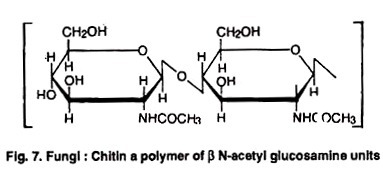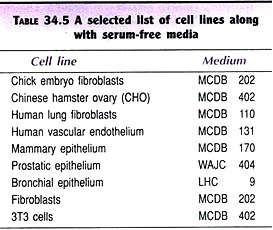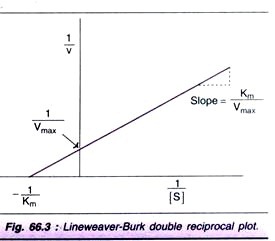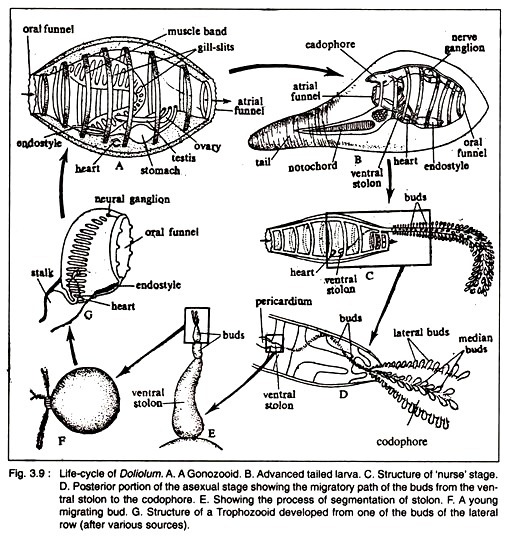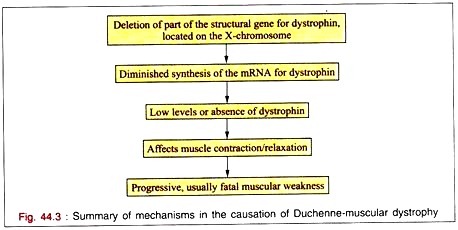Let us make an in-depth study of the biosynthesis process of fatty acid and cholesterol.
Biosynthesis of Fatty Acids:
Fatty acids are synthesized in the liver and adipose tissue. They are also synthesized in other tissues but to a small extent. Palmitic acid (16 C) is the only fatty acid synthesized in the human body; all the other fatty acids are derived from this fatty acid. Acetyl-CoA serves as the source of carbon for the synthesis of fatty acids.
The steps involved in fatty acid synthesis are:
Formation of malonyl-CoA from acetyl-CoA and bicarbonate:
Malonyl-CoA is the compound that participates in each cycle of fatty acid biosynthesis and this is synthesized from acetyl-CoA. The enzyme acetyl-CoA carboxylase or carboxykinase is a biotin bound enzyme that takes up C02 and then transfers it to acetyl-CoA forming malonyl-CoA. This is the committed step in fatty acid synthesis, acetyl-CoA carboxylase is a regulated enzyme. A cell in a low energy state will not synthesize fatty acids.
In eukaryotes, synthesis of fatty acids takes place on a large, multifunctional enzyme complex called fatty acid synthase (FAS) formed from a single polypeptide chain. This complex is arranged as a dimer with the two units placed head to tail.
Mammalian FAS consists of two identical multifunctional polypeptides, in which three catalytic domains in the ‘N-terminal’ section—ketoacyl synthase (KS), malonyl/acetyl-transferase (MAT), and dehydrase (DH)), are separated by a core region of 600 residues from four ‘C-terminal’ domains—enoyl reductase (ER), ketoacyl reductase (KR), acyl carrier protein (ACP) and thioesterase (TE).
The fatty acid synthase has two types of active sulfhydryl groups. One is provided by phosphopantetheine group of an acyl carrier protein (ACP). The other sulfhydryl group is furnished by a specific cysteine residue of 3-ketoacyl-ACP synthase enzyme. The growing fatty acid chain is always attached to the phosphopantetheine group of ACP.
The first reaction of fatty acid synthesis is the transfer of the starting units, acetyl-CoA and malonyl-CoA, from coenzyme-A to the ACP. Acetyl-CoA is transferred to the -SH group of cysteine and malonyl-CoA is transferred to -SH group of ACP.
New fatty acid is formed by condensation between the acetyl-S-Cys, contained on the enzyme 3- ketoacyl synthase and the malonyl-S-ACP to form acetoacetyl-S-ACP with the help of the same enzyme 3-ketoacyl synthase.
As in the case of degradation of fatty acids, their synthesis is performed through a cycle of four reactions. Each of these is essentially the opposite reaction of the degradation pathway, but it is not simply a reversal using the same enzyme systems.
1. The acetoaceyl-S-ACP undergoes reduction at the carbonyl group to form 3-hydroxyacyl-S-ACP. This reaction is catalyzed by the enzyme 3-ketoacyl-ACP reductase which uses NADPH as electron donor.
2. 3-hydroxyacyl-S-ACP is dehydrated by 3-hydroxyacyl-ACP dehydratase to form trans-∆2-enoyl-S- ACP.
3. The last reaction of first cycle of fatty acid synthesis is conversion of enoyl-S-ACP to saturated acyl-S-ACP by the action of the enzyme enoyl-ACP reductase which uses another NADPH as electron donor.
4. The acyl group is now transferred from the phosphopantetheine-SH group to the cysteine-SH group i.e. yet another active group on the same enzyme complex. Thus phosphopanthetheine-SH group is now free to receive yet another malonyl-CoA.
Throughout these reactions, the fatty acid chain remains linked to the ACP on the fatty acid synthase. The cycle proceeds through 7 turns to yield palmitoyl-ACP, an acyl-ACP with 16 carbon atoms. Synthesis of fatty acids by the FAS complex stops after sixteen carbons have been added (palmitate) and further elongation and the addition of double bonds are carried out by other systems.
The ACP bond is hydrolysed with the help of the enzyme hydrolase, to release the free fatty acid which almost immediately reacts with coenzyme-A to form an acyl-CoA in the cell. During synthesis of fatty acids, NADPH is used as a reducing agent, provided by HMP pathway. The diagrammatic representation of the steps involved in the biosynthesis of a fatty acid is given below.
Biosynthesis of Cholesterol:
Average diet supplies about 0.3 grams of cholesterol/day, but over 1 gram of cholesterol is synthesized in the body. Liver is the main site of cholesterol synthesis. Other organs are adrenal glands, testis, ovaries, skin, adipose tissue, muscle and brain.
The steps involved in the synthesis of cholesterol are:
Two molecules of acetyl-CoA combine by thiolase to form acetoacetyl-CoA which takes up another acetyl-CoA forming HMG-CoA in presence of the enzyme HMG-CoA synthetase. HMG-CoA then undergoes the committed step (rate limiting step) catalysed by HMG-CoA reductase to form mevalonate, a five carbon compound.
Mevalonate is activated to an isoprene unit in a series of reaction steps. The isoprene unit then multiplies exponentially to form a 10 carbon geranyl pyrophosphate which in turn forms a 15 carbon farnesyl pyrophosphate and two farnesyl pyrophosphates combine to form a 30 carbon squalene. Squalene is further modified to lanosterol and then to desmosterol finally forming cholesterol.
Regulation of Cholesterol Biosynthesis:
Cholesterol synthesis is regulated mainly at the HMG-CoA reductase step. Whenever there is excess of the end product cholesterol and its intermediate mevalonate there is feedback inhibition of HMG-CoA reductase. This enzyme activity is also regulated by phosphorylation (inactivated) with glucagon and epinephrine and dephosphorylation (activated). Other factors which control cholesterol biosynthesis are sterol carrier protein and cholesterol containing plasma lipoprotein.
Failure in the regulation of cholesterol biosynthesis is one of the factors involved in the pathological process of atherogenesis i.e. the formation of cholesterol and lipid rich deposits in arteries and arterioles. These deposits can limit blood flow and cause heart attack or strokes by depriving the tissue of an adequate supply of oxygen.
Metabolism of Bile Acids:
Functions of bile acids:
The bile acids are the glycocholic acid, taurocholic acid and glycochenodeoxycholic acid. They are good emulsifying agents they convert fat into fat droplets and expose them to aqueous environment. Bile salts stabilize the smaller particles by preventing them from coalescing.
Lipoprotein Metabolism:
Transport of Lipids to Various Parts of the Body Through Blood Plasma:
Lipids are hydrophobic and hence they cannot pass freely through the blood plasma which is hydrophilic. Thereby they combine with hydrophilic proteins, to form lipoproteins, so as to be transported through the blood to various organs.
Various types of plasma lipoproteins are:
(1) Chylomicrons
(2) Very low density lipoproteins (VLDL)
(3) Low density lipoproteins (LDL)
(4) High density lipoproteins and
(5) Albumin-free fatty acid complex.
1. Chylomicrons:
They are of intestinal origin. The protein component of chylomicrons is known as apoprotein-B. The formation of chylomicrons in the intestine takes place continuously. During fasting state the chylomicrons carry the lipids derived mainly from bile and intestinal secretions. The formation of chylomicrons increases after meals, especially after a fat rich meal, the plasma becomes opalescent (milky) due to high concentration of chylomicrons.
The chylomicrons constitute of about two percent protein and 98% of lipids (mainly TAG from digested lipids). These go to adipose tissue, heart and skeletal muscle. Lipoprotein lipase or ‘clearing factor’ an enzyme present in the capillary walls of these tissues hydrolyses the lipids of the chylomicrons and help in their deposition in the tissue. Their normal concentration in plasma is 100-250 mg/100 ml.
2. Very low density lipoproteins:
These originate from liver. They mainly carry TAG formed or synthesized in the liver. The protein content is 9% and lipids are 91%. They go to exrahepatic tissue including adipose tissue where they are hydrolysed by lipoprotein lipase. The concentration is 130-200 mg/100 ml of plasma.
3. Low density lipoproteins (LDL):
These are the lipoproteins formed from chylomicrons and VLDL. The lipoprotein lipase hydrolyses only the TAG of chylomicrons and VLDL, leaving cholesterol and phospholipids as such. These remnants then surround some more amount of protein around them getting converted to LDL. LDL is also formed in the liver afresh.
The cholesterol synthesized in the liver is transported through LDL. 50% of LDL are taken up by the extra-hepatic tissues like testes, ovaries, kidney, fibroblasts, lymphocytes and arterial smooth muscles which contain specific binding sites for LDL. The remaining 50% are taken up by liver. The protein content is 21% and lipid content is 79%. Their normal concentration in the plasma is 210- 400 mg/100 ml.
4. High density lipoproteins:
They are both of liver and intestinal origin. They are made up of 33% of proteins and 67% of lipids. The lipids are mainly phospholipids and cholesterol. The cholesterol in HDL is esterified by an enzyme lecithin-cholesterol acyltransferase, which transfers a fatty acid from lecithin to cholesterol to form the cholesterol ester.
The cholesteryl ester of HDL is transferred to VLDL and LDL by a cholesteryl ester transfer protein. HDL takes up the cholesterol, from the tissue and transport them to liver, thus prevent Atherosclerosis. Hence they are also known as scavengers for cholesterol. Their normal concentration in the blood plasma is 50-130 mg/100 ml. The protein is apo-A & C.
Free Fatty Acids — Albumin Complex:
They arise in the plasma from lipolysis of TAG in adipose tissue or as a result of the action of lipoprotein lipase during uptake of plasma TAG from chylomicrons and VLDL. The released free fatty acids combine with albumin to form free fatty acid-albumin complex.
Their concentration during full fed state is about 0.02-0.03 micro equivalents/ml of blood plasma which rises to 0.5 during post absorptive state and in fasting condition it is 0.7 to 0.8. In uncontrolled diabetes it is 2 micro eq./ml. About 50% of FFA-albumin is taken up by the extra-hepatic tissues like heart and skeletal muscle.
Fatty Liver:
Abnormal accumulation of fats in the liver is known as fatty liver. The lipid content of the liver is 5% under normal conditions. A rise in the lipid content of the liver to about 25% to 30% leads to fatty livers. This leads to disruption in the normal activities of the liver which may lead to jaundice.
There are two types of fatty livers:
1. Physiological fatty livers:
Physiological fatty livers arise due to increased mobilization of fatty acids to the liver, more than the liver can metabolize. Hence it leads to accumulation of fats in the liver causing fatty livers. The causes of physiological fatty liver may be starvation, diabetes, hyper secretion of hormones like epinephrine, glucagon and GH causing lipolysis.
2. Pathological fatty livers:
In this case the fatty acids may be coming to the liver in normal amounts but the liver is not able to produce lipoproteins to clear the lipids which again leads to fatty livers.
Non production of lipoproteins may be due to:
(i) Defective liver due to alcoholism
(ii) Metabolic block in apoprotein synthesis
(iii) Infections of the liver
(iv) Deficiency of lipotropic factors
Lipotropic Factors:
Substances which prevent or relieve abnormal accumulation of lipids in the liver are called lipotropic factors or lipid clearing factors.
The various lipotropic factors and their action are:
1. Choline:
It serves as a base for the synthesis of phosphatidyl choline (lecithin), which is necessary for the formation of lipoproteins.
2. Betaine and methionine:
Supply methyl groups for the synthesis of choline in the body.
3. Glycine and serine:
Serve as precursors for the synthesis of choline.
4. Folic acid and vitamin B12:
Act as coenzyme for transfer of methyl groups in the synthesis of choline.
5. Threonine:
An important amino acid of hepatic enzymes for the synthesis of choline. Other lipotropic factors are essential fatty acids, pyridoxine, inosine, vitamin E and selenium.
Metabolism of Adipose Tissue:
Adipose tissue is the sub-cutaneous tissue which mainly functions for the storage of fats. Fats are stored in the adipose tissue as fat droplets of triacylglycerol’s in large vacuoles. Under normal conditions the triacylglycerol’s of the adipose tissue are broken down to glycerol and free fatty acids.
The glycerol so obtained, passes through the circulation to the liver for further oxidation. The free fatty acids get esterified to 3-phosphoglycerate, obtained from the glycolysis in the adipose tissue to form triacylglycerol’s. This is a continuous process in the adipose tissue and it occurs even under normal conditions i.e. under well fed conditions.
The glycerol obtained from the break-down of the TAG cannot be reutilized for the re-synthesis of TAG, hence it diffuses into the circulation. Only the 3-phosphoglycerate from glycolysis can be utilized for the re-synthesis of TAG. This is a well-developed mechanism to differentiate between a well fed condition and starvation condition.
During the well fed condition, glucose will be easily available for the adipose tissue, thereby glycolysis will be continuously operating and hence there is a continuous supply of 3-phosphoglycerate for the re-esterification of the free fatty acids. But, during the starvation period there is deficiency of glucose, therefore there will be deficiency in the availability of 3-phosphoglycerate ultimately resulting in non-esterification of FFA which thus diffuses into the blood and combines with albumin to form the ‘FFA-albumin’ complex. This in turn is transported to various organs for utilization.
When again the subject is well fed there will be an easy availability of glucose which causes re-esterification of the FFA and thereby its supply is stopped to the other organs. The relationship of the availability and non-availability of glucose to the supply and re-esterification of FFA is termed as the ‘glucose- fatty acid cycle’.
Brown Adipose Tissue:
It is also a sub-cutaneous tissue and stores an excess amount of fat than the adipose tissue. This tissue appears reddish brown in colour, because it contains large amounts of mitochondria and each mitochondrion with an extra number of cytochromes than the normal mitochondria.
As the cytochromes are reddish brown in colour (due to the porphyrin ring) the adipose tissue appears reddish brown in colour. Hence it is known as brown adipose tissue and the mitochondrion present in it is called brown fat mitochondria. The main purpose of this tissue is the production of heat.
In the brown adipose tissue the catabolism of the TAG gives rise to only one ATP and large amounts of heat. The production of ATP is less but the production of heat is more because the brown fat mitochondria contain a protein called ‘thermogenin’ which uncouples oxidative phosphorylation. In this way the brown adipose tissue regulates the body temperature.
Brown adipose tissue is generally found in new born infants and children on their neck and back side of their trunk. Infants and children generally have a very thin layer of sub-cutaneous fat pad, therefore there is no restriction for the loss of heat or there is no insulation for the prevention of loss of heat. Hence over production of heat by the brown adipose tissue helps in the regulation of the body temperature in children.
Brown adipose tissue is rarely found in adults. Such adults or persons can never become obese/fat because the extra carbohydrates and fats taken by such individuals are utilized by the brown adipose tissue and therefore lost as heat.




